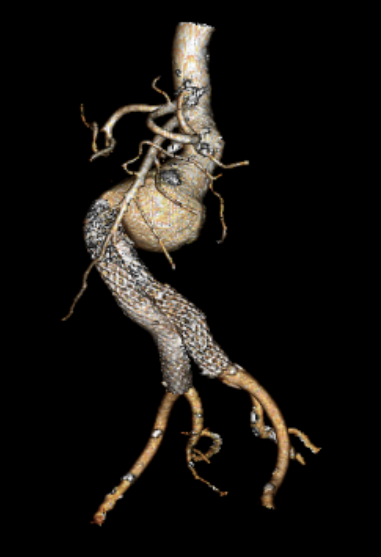|
Back to Annual Meeting Posters
Treatment of Extensive Distal Aortic Stent Graft Migration Using Powerlink Bifurcated Unibody Device
Habib Khan, MD, Hasan Dosluoglu, MD, Richard Curl, MD.
Univesity at Buffalo, Buffalo, NY, USA.
INTRODUCTION:
Device migration after endovascular aneurysm repair (EVAR) is a known complication with reported rates as high as 16%. Associated proximal type 1 endoleak is a significant risk factor for rupture. Endovascular reintervention can be challenging but conversion to open surgery is fraught with complications and results in high morbidity and mortality. We report a case of a high-risk patient who presented with rapid, symptomatic aneurysm expansion secondary to graft migration 8 years post procedure which was successfully treated with Endologix Powerlink stent-graft.
CASE REPORT:
A 74 year old man with history of coronary artery disease(CAD) s/p coronary artery bypass grafting(CABG), hypertension, asthma, hypercholesterolemia, chronic renal impairment and basal cell carcinoma, underwent an uneventful EVAR for an asymptomatic 6.2cm infrarenal abdominal aortic aneurysm (AAA) using an AneuRx (Medtronic Vascular, Santa Rosa) stent-graft. Post-operatively, the aneurysm sac size decreased to 5.4cm and remained stable until 8 years post-operatively, when it was noted to increase to 7cm upon duplex ultrasound, confirmed by CTA to be 8.7cm. (Fig.)
Initial plan was to extend the stent-graft proximally to just below the superior mesenteric artery (SMA) and stent the renal arteries using a “double chimney” technique. A Powerlink cuff (Endologix, Inc, Irvine, Calif) was successfully deployed but the cuff separated from the AneuRx intra-operatively. An attempt to bridge the gap between the two devices by placement of a second cuff was again unsuccessful. An Endologix bifurcated graft was then used which was seated on the AneuRx flow divider and extended proximally to just below the SMA. No attempt was made to salvage renal arteries. Completion angiogram did not show any endoleak and the patient was subsequently discharged home. CTA performed 8 months post-procedure showed stable sac size and patient remained asymptomatic.
CONCLUSIONS:
Distal migration with proximal type 1 endoleak is one of the most challenging clinical entities post EVAR. Aorto-uniliac devices with femoro-femoral bypass have been the preferred modality for its treatment but use of short main body bifurcated device could be a reasonable alternative in patients with multiple co-morbidities in whom an additional femoro-femoral bypass is not desired. 
Back to Annual Meeting Posters

|


